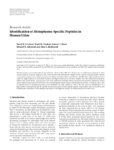1 - 25 of 25
| Creator | Title | Description | Subject | Date | ||
|---|---|---|---|---|---|---|
| 1 |
 |
Digre, Kathleen B.; Blumenthal, Deborah T.; Cessna, Melissa H.; Gopez, Evelyn V.; Shen, Yue | Carcinomatous meningitis as the presenting manifestation of gallbladder carcinoma: case report and review of the literature | The primary tumors that typically cause carcinomatous meningitis include lung cancer, breast cancer, leukemia, lymphoma and melanoma. A variety of neurological signs and symptoms can be seen depending on the extent and location of the meningeal metastasis. Once the diagnosis of carcinomatous meningi... | Carcinomatous Meningitis; Gallbladder Carcinoma; Leptomeningeal Metastasis; Meningeal Carcinomatosis; Cranial Neuropathy | 2004-10 |
| 2 |
 |
Digre, Kathleen B.; Blumenthal, Deborah T.; Salzman, Karen L.; Jensen, Randy L.; Dunson, William A. | Early pathologic findings and long-term improvement in anti-Ma2-associated encephalitis. | A 67-year-old man sequentially developed anti-Ma2-associated paraneoplastic encephalitis (PNE) and contralateral herpes simplex encephalitis (HSE). Brain biopsy 1 month before HSE revealed extensive infiltrates of T cells, B cells, and plasma cells. Most T cells expressed the cytotoxic granule-assoc... | Paraneoplastic neurologic disorders; Encephalitis; Neoplasm;Herpes Simplex | 2006-07-11 |
| 3 |
 |
Bernstein, Paul S. | Skin carotenoid status measured by resonance Raman spectroscopy as a biomarker of fruit and vegetable intake in preschool children | Background/Objective: Dietary assessment in children is difficult, suggesting a need to develop more objective biomarkers of intake. Resonance Raman spectroscopy (RRS) is a noninvasive, validated method of measuring carotenoid status in skin as a biomarker of fruit/vegetable intake. The purpose of t... | 2012-01-01 | |
| 4 |
 |
Bernstein, Paul S.; Leppert, Mark F. | Genotype-phenotype analysis of ABCR variants in macular degeneration probands and siblings | PURPOSE: Single-copy variants of the autosomal recessive Stargardt disease (STGD1) gene ABCR (ABCA4) have been shown to confer enhanced susceptibility to age-related macular degeneration (AMD). To investigate the role of ABCR alleles in AMD further, genotype-phenotype analysis was performed on sibli... | DNA Mutational Analysis; Nuclear Family; Phenotype | 2002 |
| 5 |
 |
Kriesel, John D.; Gooch, Willis M.; Pavia, Andrew T. | Invasive sinonasal disease due to Scopulariopsis candida: case report and review of scopulariopsosis. | Sinonasal infection with fungi of the order Mucorales--termed mucormycosis or zygomycosis--is sometimes seen in immunosuppressed patients, including those with diabetic ketoacidosis and malignancy. We describe a case of invasive sinonasal infection with Scopulariopsis candida (not among the Mucorale... | Granulocyte Colony-Stimulating Factor; Itraconazole; Maxillary Sinus | 1994 |
| 6 |
 |
Baehr, Wolfgang | Trilateral tumors in four different lines of transgenic mice expressing SV40 T-antigen | PURPOSE. A line of transgenic mice containing the simian virus (SV) 40 T-antigen (T-ag) gene driven by the beta-luteinizing hormone (BLH) promoter developed bilateral retinoblastoma and primitive neuroectodermal tumors (PNET) of the midbrain. Midbrain tumors arose from the subependymal layer of the ... | Mice, Transgenic; Retinol-Binding Proteins; Eye Proteins | 1996 |
| 7 |
 |
Askew, Eldon W.; Bernstein, Paul S. | Serum and macular responses to antioxidant supplementation verus a carotenoid-rich dietary intervention in the elderly. | The aim of this study was to observe responses of serum antioxidants, oxidative stress biomarkers, and macular carotenoid pigments to antioxidant supplements or dietary intervention in a single-masked, randomized, pilot clinical study of elderly subjects receiving antioxidant supplements or a dietar... | Macula; Serum Carotenoids; Zeaxanthin | 2006-02-01 |
| 8 |
 |
Crockett, David K. | Utility of gene-specific algorithms for predicting pathogenicity of uncertain gene variants | The rapid advance of gene sequencing technologies has produced an unprecedented rate of discovery for genome variation in humans. A growing numbered of authoritative clinical repositories archive gene variants and disease phenotype, yet there are currently many more gene variants that lack clear ann... | 2012 | |
| 9 |
 |
Crockett, David K. | Identification of histoplasma -specific peptides in human urine | Histoplasmosis is a severe dimorphic fungus infection, which is often difficult to diagnose due to similarity in symptoms to other diseases and lack of specific diagnostic tests. Urine samples from histoplasma-antigen-positive patients and appropriate controls were prepared using various sample prep... | 2012-01-01 | |
| 10 |
 |
Bernstein, Paul S. | Transformations of selected carotenoids in plasma, liver, and ocular tissues of humans and in nonprimate animal models | PURPOSE: To determine the stereochemistry of carotenoids in human ocular tissues in comparison with plasma and liver and to elucidate the possible transformations of dietary (3R,3'R,6'R)-lutein and (3R,3'R)-zeaxanthin in the eye. Similarly, to characterize the carotenoid profiles in the eye tissues,... | Chromatography, High Pressure Liquid; Stereoisomerism; Xanthophylls | 2002 |
| 11 |
 |
Bernstein, Paul S. | Identification of lutein and zeaxanthin oxidation products in human and monkey retinas | PURPOSE: To characterize fully all the major and minor carotenoids and their metabolites in human retina and probe for the presence of the oxidative metabolites of lutein and zeaxanthin. METHODS: Carotenoids of a composite of 58 pairs of human retinas and a monkey retina were elucidated by comparing... | Mass Spectrometry; Oxidation-Reduction; Spectrophotometry, Ultraviolet | 1997 |
| 12 |
 |
Frederick, Jeanne M.; Thulin, Craig; Bernstein, Paul S. | Identification and characterization of a Pi isoform of glutathione S-transferase (GSTP1) as a zeaxanthin-binding protein in the macula of the human eye | Uptake, metabolism, and stabilization of xanthophyll carotenoids in the retina are thought to be mediated by specific xanthophyll-binding proteins (XBPs). A membrane-associated XBP was purified from human macula using ion-exchange chromatography followed by gel-exclusion chromatography. Two-dimensio... | Circular Dichroism; Isoelectric Focusing; Macula Lutea; Xanthophylls | 2004 |
| 13 |
 |
Digre, Kathleen B.; Skuster, Denise Z. | Neurologic conditions presenting as psychiatric disorders. | Understanding underlying neuroanatomic function helps physicians to localize defects and search for treatable neurologic conditions. Neurologic conditions such as Huntington's chorea, Wilson's disease, Gille de la Tourette syndrome, brain tumors, encephalitis and meningitis, neurodegenerative condit... | Psychiatric Diagnosis; Neurologic Disease | 1992-06-15 |
| 14 |
 |
Digre, Kathleen B.; Blumenthal, Deborah T.; Salzman, Karen L.; Jensen, Randy L.; Dunson, William A. | Early pathologic findings and long-term improvement in anti-Ma2-associated encephalitis. | A 67-year-old man sequentially developed anti-Ma2-associated paraneoplastic encephalitis (PNE) and contralateral herpes simplex encephalitis (HSE). Brain biopsy 1 month before HSE revealed extensive infiltrates of T cells, B cells, and plasma cells. Most T cells expressed the cytotoxic granule-assoc... | Paraneoplastic neurologic disorders; Encephalitis; Neoplasm;Herpes Simplex | 2006-07-11 |
| 15 |
 |
Jaeckle, Kurt A.; Digre, Kathleen B.; Jones, Christopher R.; Bailey, Peter L. | Central neurogenic hyperventilation: pharmacologic intervention with morphine sulfate and correlative analysis of respiratory, sleep, and ocular motor dysfunction. | Central neurogenic hyperventilation (CNH), for which there is no effective therapy, can eventually result in respiratory fatigue and death. This report describes a patient with CNH due to a brainstem anaplastic astrocytoma who also exhibited disturbances of sleep and ocular motor function. The CNH r... | Central Neurogenic H yperventilation; Ocular Motor Dysfunction | 1990-11 |
| 16 |
 |
Baehr, Wolfgang | Bilateral retinal and brain tumors in transgenic mice expressing simian virus 40 large T antigen under control of the human interphotoreceptor retinoid-binding protein promoter | We have previously shown that postnatal expression of the viral oncoprotein SV40 T antigen in rod photoreceptors (transgene MOT1), at a time when retinal cells have withdrawn from the mitotic cycle, leads to photoreceptor cell death (Al-Ubaidi et al., 1992. Proc. Natl. Acad. Sci. USA. 89:1194-1198).... | Simian virus 40; Retinol-Binding Proteins; Promoter Regions (Genetics) | 1992 |
| 17 |
 |
Bernstein, Paul S. | Evaluation of the G protein coupled receptor-75 (GPR75) in age related macular degeneration | 2001 | ||
| 18 |
 |
Bernstein, Paul S. | Retinal tubulin binds macular carotenoids | PURPOSE: To investigate the biochemical mechanisms responsible for the specific uptake, concentration, and stabilization of the carotenoids lutein and zeaxanthin in the macula. METHODS: Soluble extracts of bovine retina mixed with radioactive carotenoids were purified by hydrophobic interaction, ion... | Chromatography, Gel; Electrophoresis; Xanthophylls | 1997 |
| 19 |
 |
Kriesel, John D. | Helicase-primase inhibitor pritelivir for HSV-2 infection | Background Pritelivir, an inhibitor of the viral helicase-primase complex, exhibits antiviral activity in vitro and in animal models of herpes simplex virus (HSV) infection. We tested the efficacy and safety of pritelivir in otherwise healthy persons with genital HSV-2 infection. Methods We randomly... | 2014-01-01 | |
| 20 |
 |
Baehr, Wolfgang | Human interstitial retinoid-binding protein. Gene structure and primary structure | Interstitial retinoid-binding protein (IRBP) is synthesized and secreted by rod photoreceptor cells into the interphotoreceptor matrix and is known to bind retinoids and fatty acids. We have used cDNA clones encoding human IRBP to isolate a 15-kilobase genomic fragment that encompasses the complete ... | Molecular Sequence Data; Eye Proteins; Retinol-Binding Proteins; Messenger RNA | 1989-05-15 |
| 21 |
 |
Frederick, Jeanne M. | The prenyl-binding protein PrBP/δ: A chaperone participating in intracellular trafficking | Expressed ubiquitously, PrBP/d functions as chaperone/co-factor in the transport of a subset of prenylated proteins. PrBP/d features an immunoglobulin-like b-sandwich fold for lipid binding, and interacts with diverse partners. PrBP/d binds both C-terminal C15 and C20 prenyl side chains of phototran... | 2012-01-01 | |
| 22 |
 |
Baehr, Wolfgang | Identification and light-dependent translocation of a cone-specific antigen, (Cone Arrestin) recognized by monoclonal antibody 7G6 | PURPOSE: To elucidate the antigen recognized by monoclonal antibody (mAb) 7G6, a widely used cone-specific marker. METHODS: 7G6 immunocytochemistry was performed on sections of human, primate, and bovine retina. The antigen was immunoprecipitated from human retinal lysates and purified with protein ... | Cones (Retina); Molecular Sequence Data; Phototransduction | 2003 |
| 23 |
 |
Zhang, Kang | Spectrum and frequency of FZD4 mutations in familial exudative vitreoretinopathy | Mutations in the frizzled-4 gene (FZD4) have recently been associated with autosomal dominant familial exudative vitreoretinopathy (FEVR) in families linking to the EVR1 locus on the long arm of chromosome 11. The purpose of this study was to screen FZD4 in a panel of 40 patients with FEVR to ident... | Frizzled-4 gene; FZD4; Mutation; autosomal dominant familial exudative autosomal dominant familial exudative; FEVR | 2004 |
| 24 |
 |
Fuhrmann, Sabine; Zhang, Jianmin; Vetter, Monica L. | Investigation of Frizzled-5 during embryonic neural development in mouse | Cellular and tissue--tissue interactions regulate development of the central nervous system (CNS) and a paramount question is what is the nature of the signals involved in these interactions. The vertebrate eye represents an excellent and challenging CNS model because it contains multiple cell and ... | Mouse; Eye; Optic cup; Morphogenesis; Retina; Lens; Wnt; Frizzled; Pituitary | 2008 |
| 25 |
 |
Baehr, Wolfgang | Pharmacological and rAAV gene therapy rescue of visual functions in a blind mouse model of Leber congenital amaurosis | BACKGROUND: Leber congenital amaurosis (LCA), a heterogeneous early-onset retinal dystrophy, accounts for approximately 15% of inherited congenital blindness. One cause of LCA is loss of the enzyme lecithin:retinol acyl transferase (LRAT), which is required for regeneration of the visual photopigmen... | Disease Models, Animal; Genetic Vectors; Molecular Sequence Data | 2005 |
1 - 25 of 25
